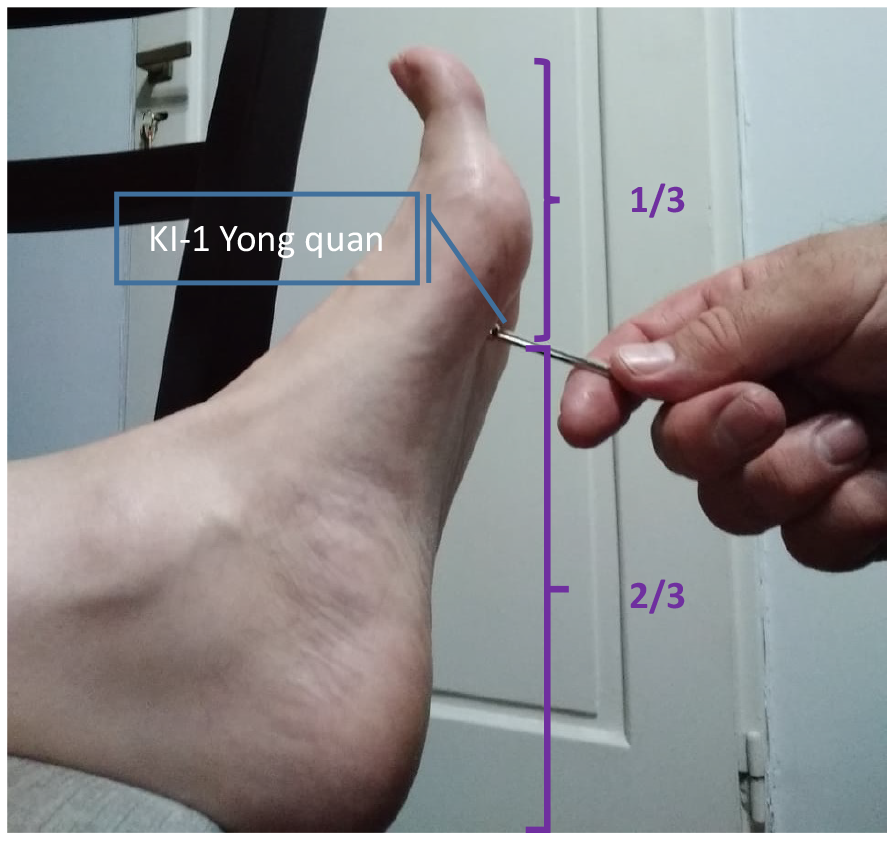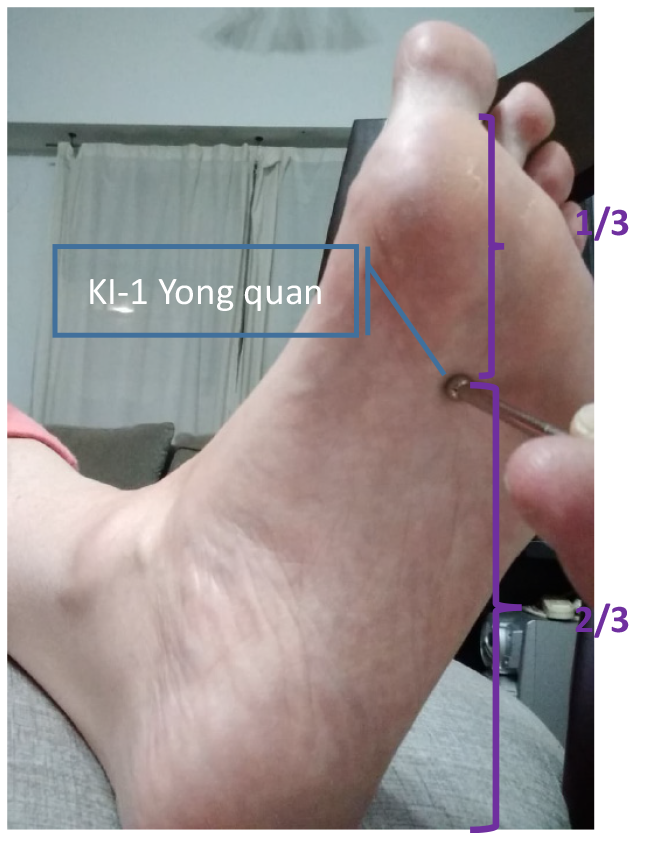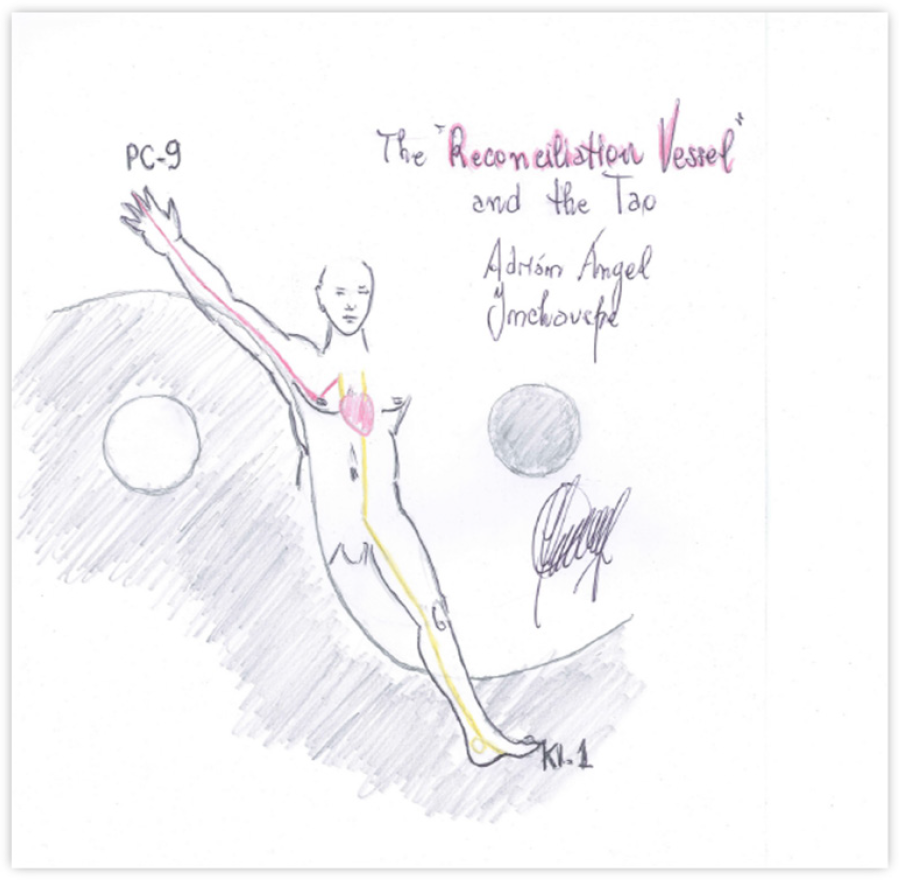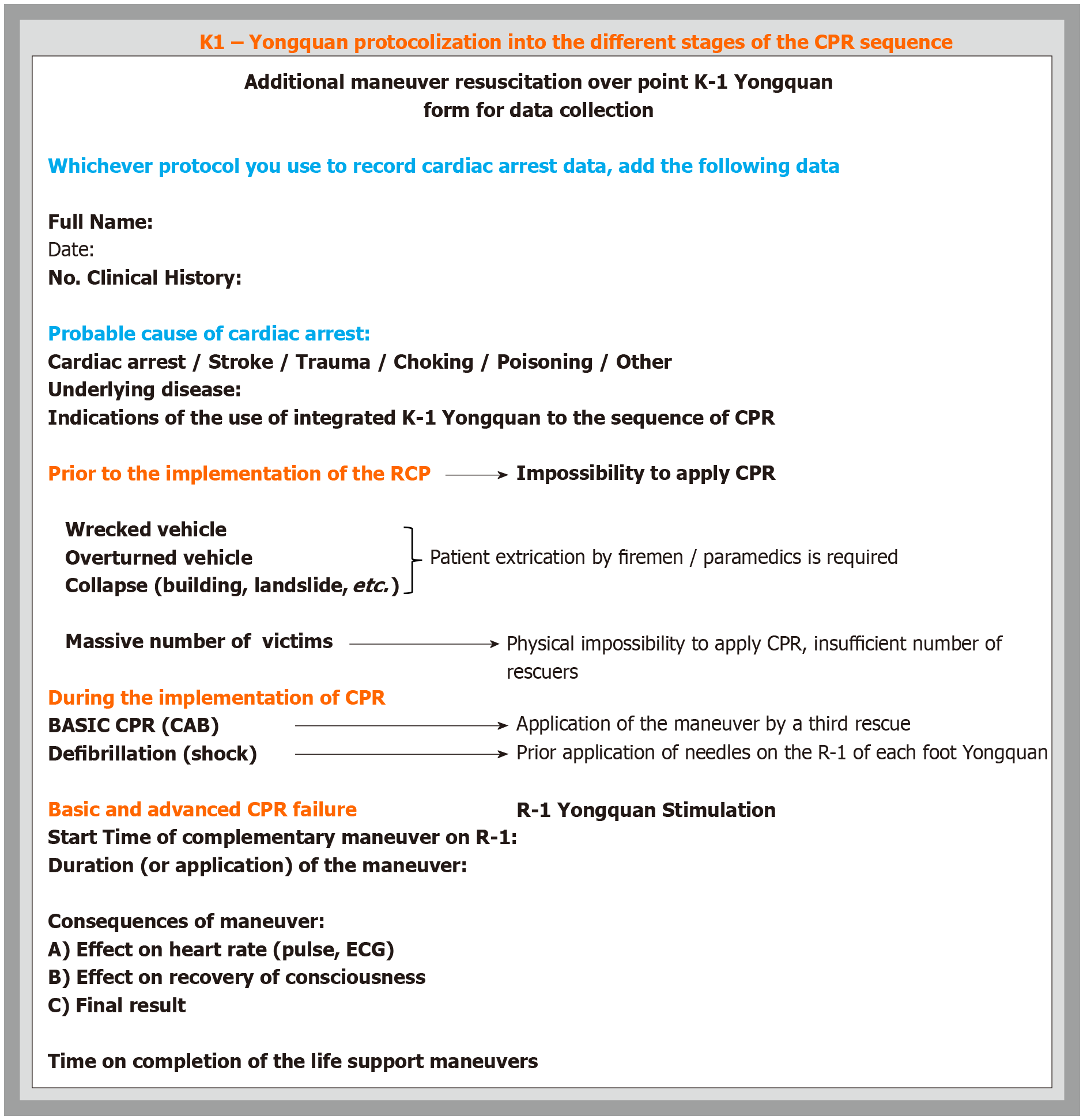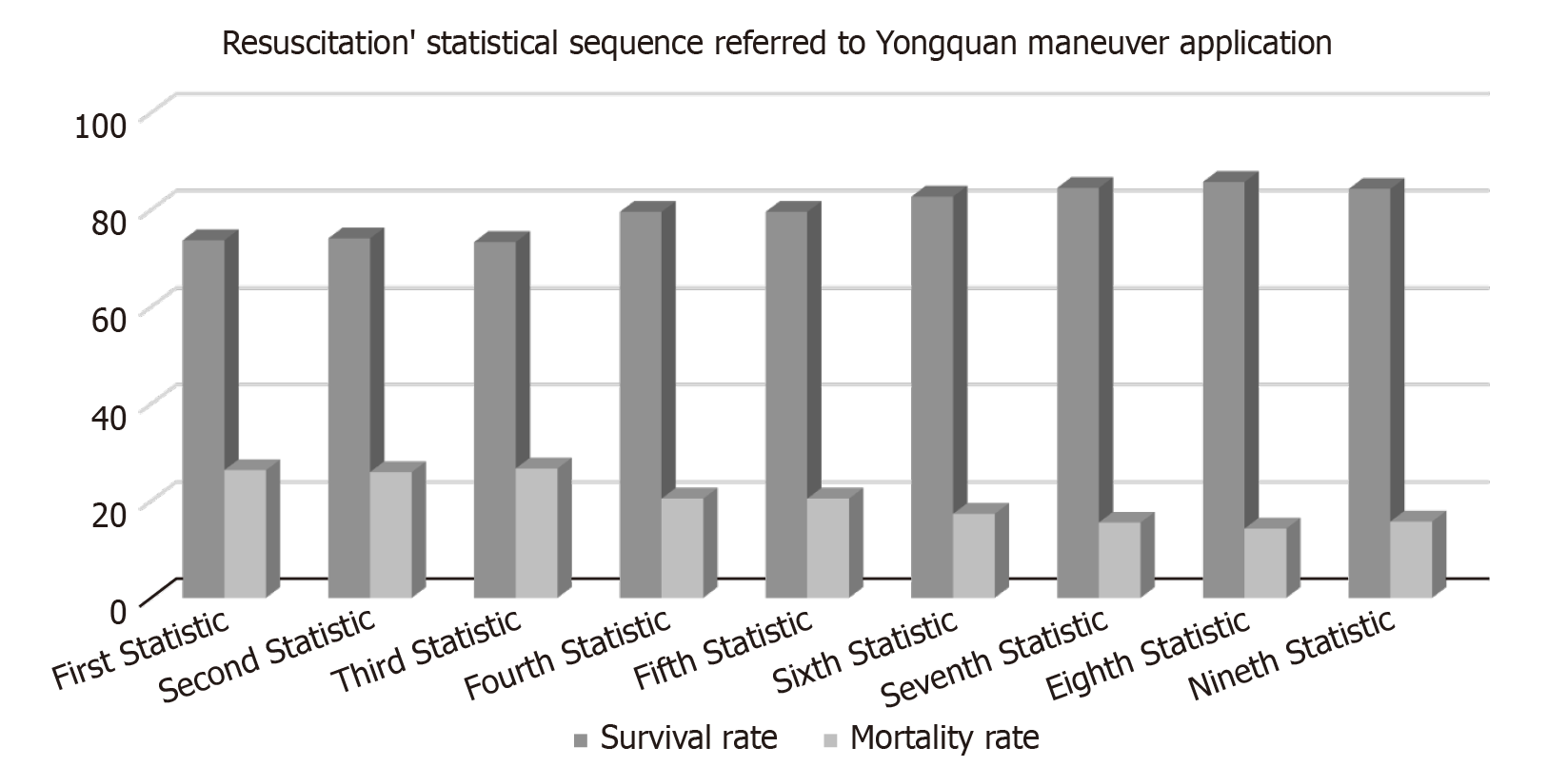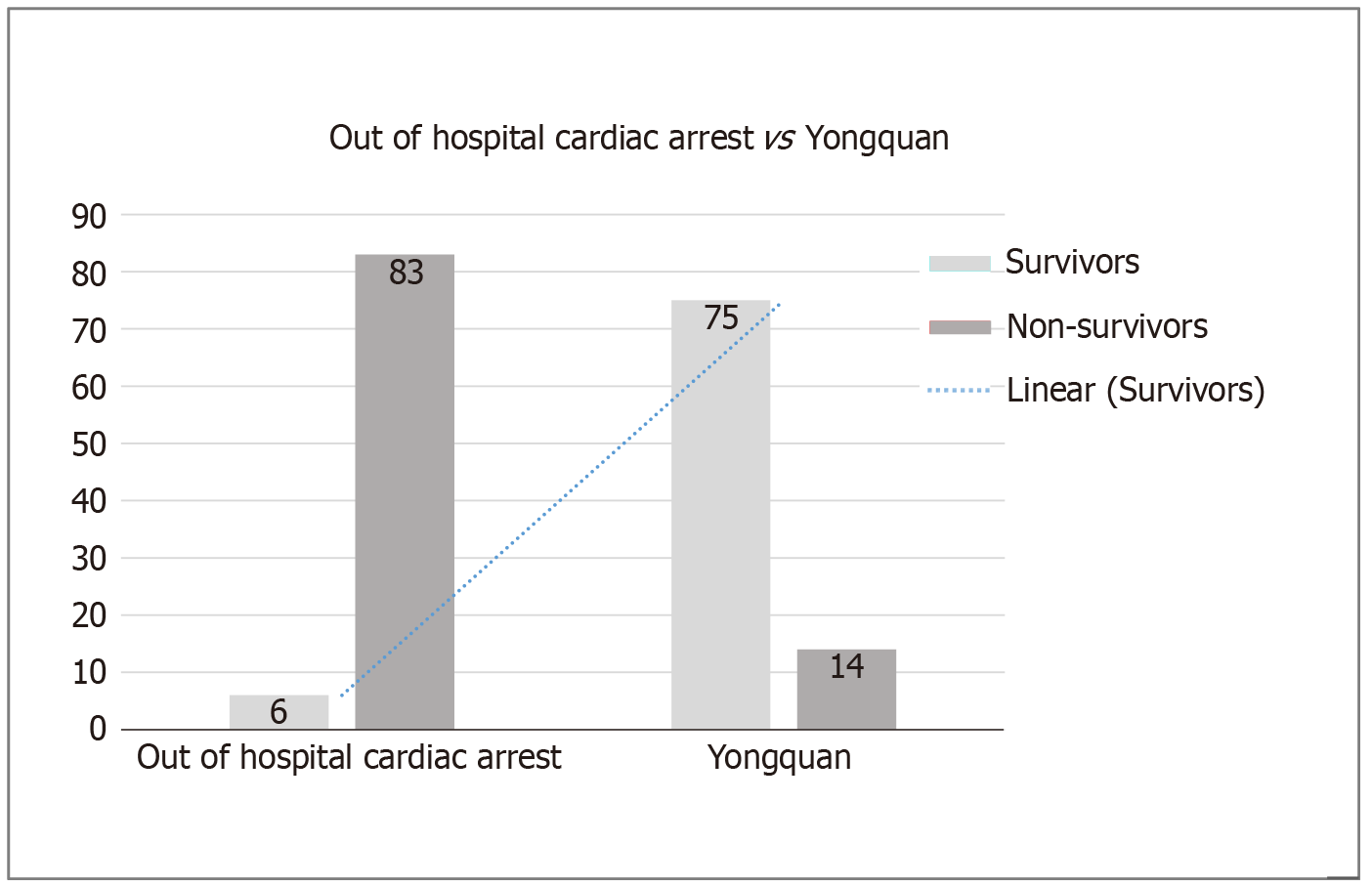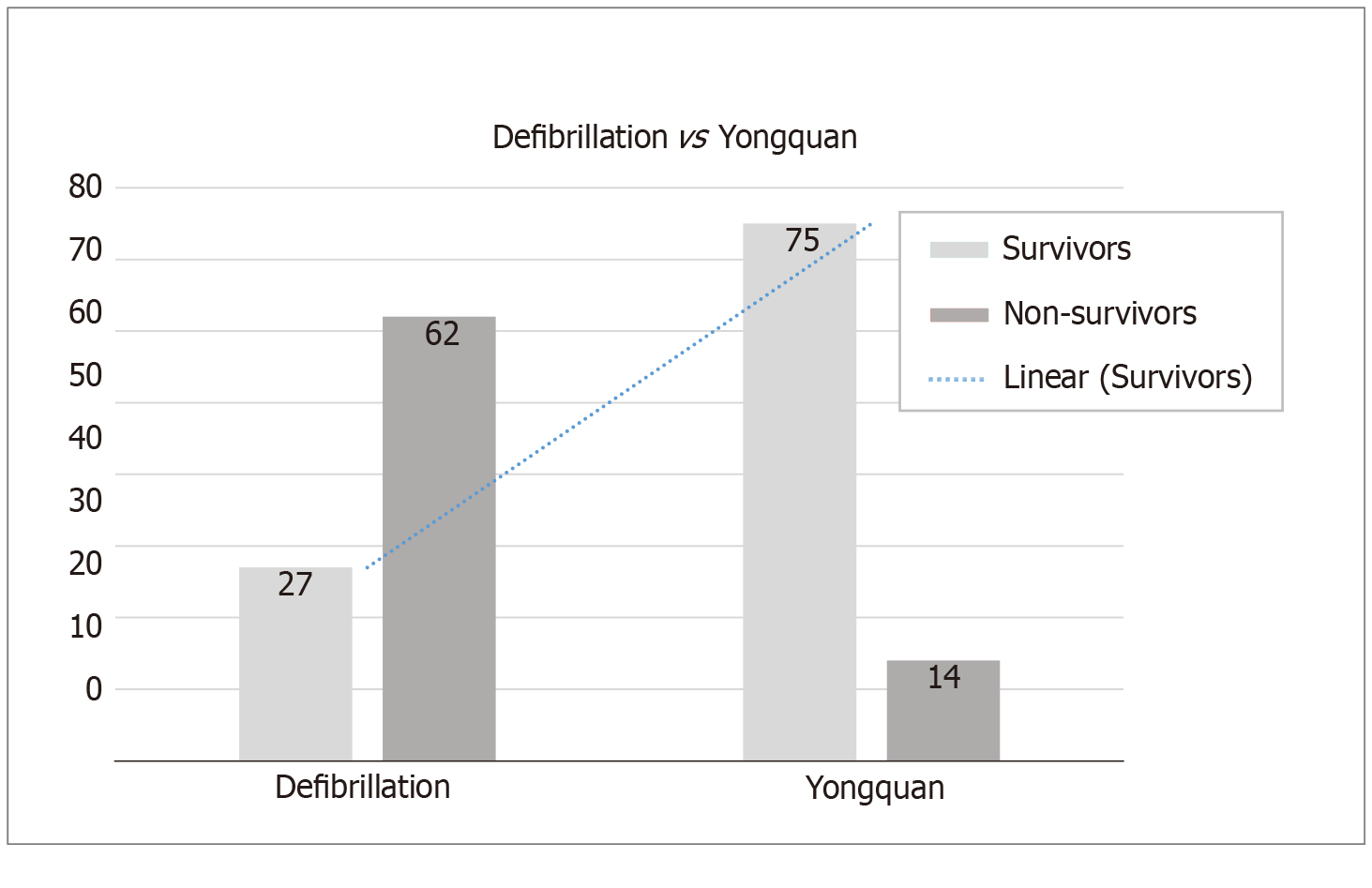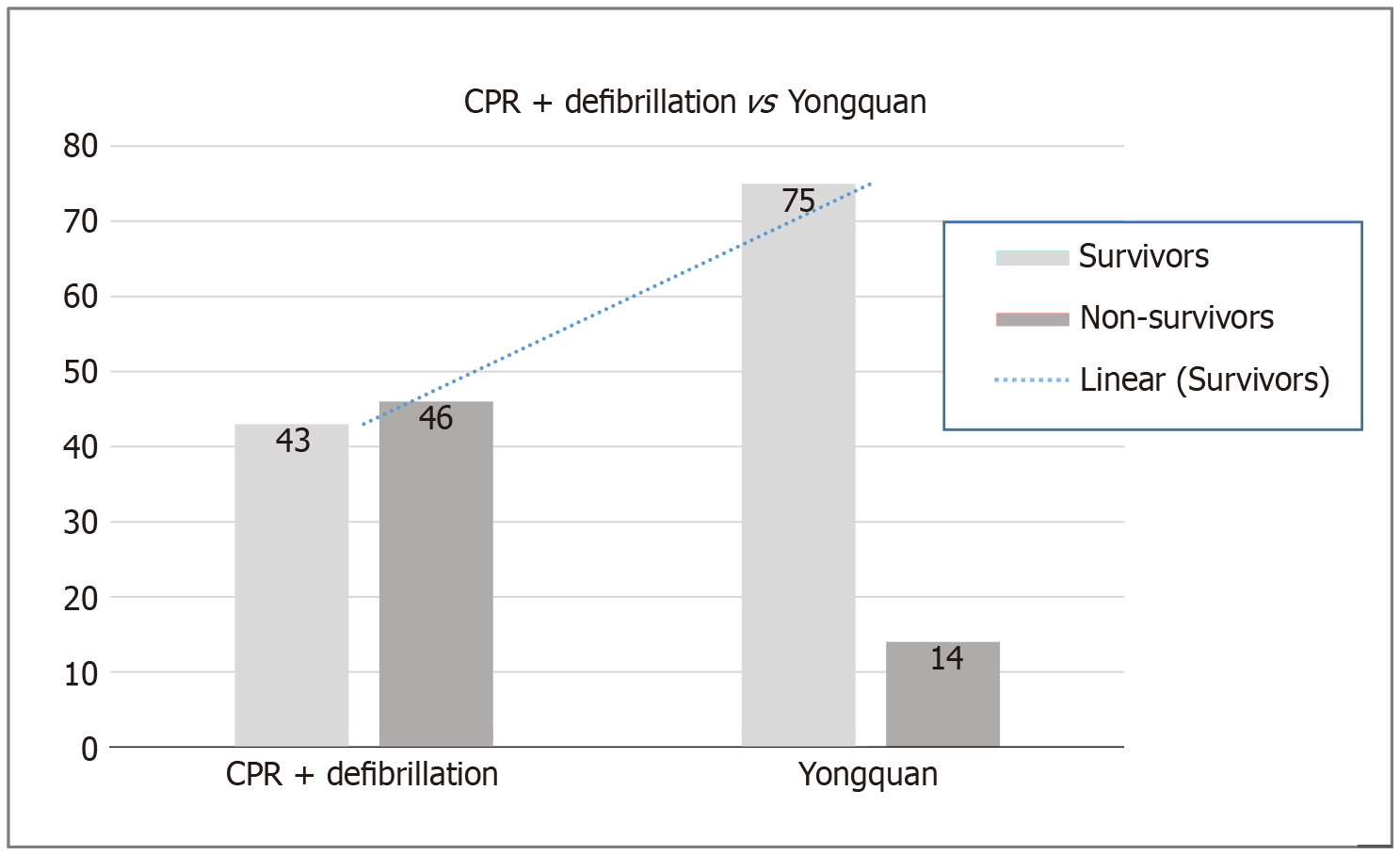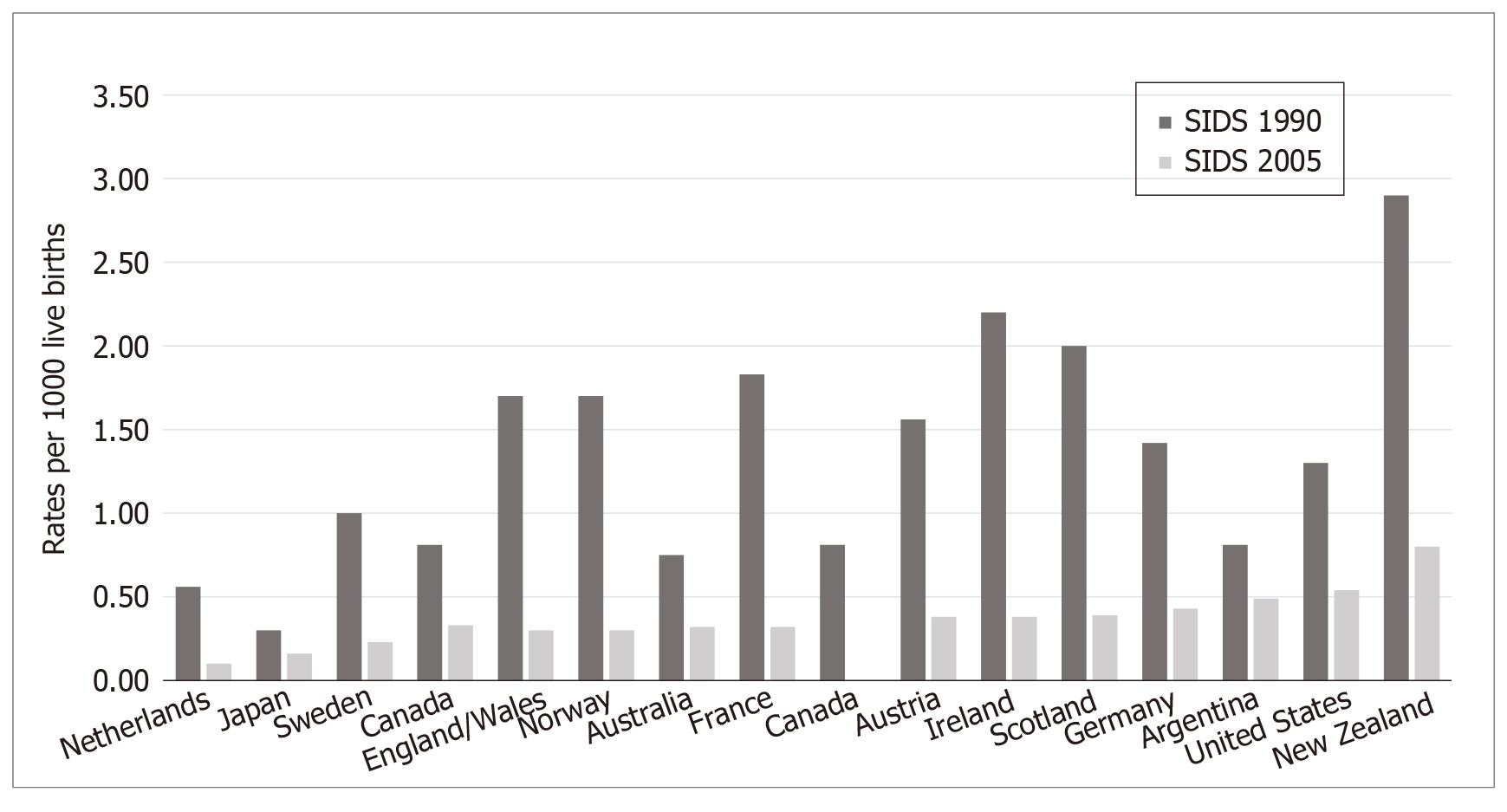Published online Jul 9, 2021. doi: 10.5492/wjccm.v10.i4.151
Peer-review started: February 10, 2021
First decision: March 17, 2021
Revised: May 1, 2021
Accepted: June 2, 2021
Article in press: June 2, 2021
Published online: July 9, 2021
Processing time: 146 Days and 3.4 Hours
As it has been established in previous publications of the author, the current extra-hospital statistics referring to cardiopulmonary resuscitation (CPR) are far from being minimally satisfactory (14%-17% success). Since the appearance of acquired immune deficiency syndrome, its application has been increasingly undermined as other subsequent pandemics (H1N1, Ebola, coronavirus disease 2019) seriously infringing lay rescuers intervention during classical CPR steps (mouth-to-mouth ventilation), forcing to modify vital support protocols. Both KI-1 Yong quan and PC-9 Zhong chong alternative rescue maneuvers could come to aid those victims of impending death situation due to both cardiac arrest or stroke, upgrading current survival rates of said unfortunate patients.
To validate a complementary resuscitation maneuver originated in Chinese Medicine knowledge, carefully integrated into international CPR protocols [World Journal of Critical Care Medicine (WJCCM), August 2013].
The model to verify its statistical validity of quoted research was the Retrospective Cohort Study, which redeems the “semiotic paradigm” that gave rise to medical semiotics. Its value strives in the differential detail if the deceased patients are considered the control group instead of the patients that may be deceased. Thus, combining the semiotic paradigm with the Retrospective Cohort Study allows us to manage the collateral potential lethal effects of the random process in cases of extreme emergencies.
The statistic results provided by the methodological analysis of this work were previously published in WJCCM August 2013, ISSN 2220-3141). In a total of 89 patients in which the Yong quan maneuver was tested, 75 survived and 14 died. In order to compare this data with the percentages of survivors in the other maneuvers, we stipulate the assumption that if 89 patients are the 100% of the sample, how many patients would survive if the survival rate is 6.4% in CPR, 30% in defibrillation and 48% in CPR + defibrillation. By this way we obtained the approximate values of patients that would survive when applying these classical resuscitation maneuvers. Then we obtained the format of the tables to perform the exact Fisher test with the help of a statistical processor; the consequent result in a valuation of P < 0.0001 was considered "extremely statistically significant".
The author herein provides a methodological–statistical analysis of such contribution which does not imply any cost at all and could even help prevent the withdrawal of classical CPR practices.
Core Tip: Against current pandemic scenario, the author analyzes the possible difficulties that could occur on essential life support protocols as cardiopulmonary resuscitation (CPR). As happened with the previous H1N1 pandemic, from when it was decided to postpone the "kiss to life" (mouth ventilation) giving priority to the precordial massage, coronavirus disease 2019 global situation could drastically reduce survival rates due to CPR and life-support protocols. For this reason, the author insists on an additional complementary resuscitation maneuver from Traditional Chinese Medicine - already published by the World Journal of Critical Care Medicine in Beijing in August 2013, in order to improve the rescue success in sudden death and out-of-hospital cardiac arrest.
- Citation: Inchauspe AA. COVID-19 and resuscitation: La tournée of traditional Chinese medicine? World J Crit Care Med 2021; 10(4): 151-162
- URL: https://www.wjgnet.com/2220-3141/full/v10/i4/151.htm
- DOI: https://dx.doi.org/10.5492/wjccm.v10.i4.151
The cardiopulmonary resuscitation (CPR) maneuver can be considered to constitute the most important medical act that exists in universal medicine. Both in the East and in the West, its medical significance acquired such importance that even those who are not practicing physicians or involved otherwise in Medical or Health Sciences manage to be authorized once they have been instructed in the "chain of events" incorporated into the life support protocol sequences[1].
Following the American Heart Association, the CPR aims - understood as the reversal of clinical death - are to preserve life, restore health and limit disabilities, although such benefits can, in fact, only be achieved by a limited number of victims, whose dispositions and pathologies are more often than not totally unknown to the eventual rescuers, whose mission, in turn, is to save them from such a dire situation[2,3].
According to World Health Organization (WHO), more than 23% of all causes of death are due to cardiovascular factors. If to that percentage we add up that of cerebrovascular diseases, the total surpasses 30% of all existing causes of death. For this reason, by the end of 2020, beyond this gloomy pandemic crisis that affects us, the number of deaths due to cardiac arrest could reach a staggering 30000000 deaths per year[4]. Taking a current example, the results of the extrahospital rescues only reaches the meager figure of 6.5% with precordial massage and of 17%, when defibrillation is used. If the total death toll during World War II was estimated to be around 50,000,000 along the course of four years of devastation, it should not be difficult for us to consider that we are facing a true sanitary catastrophe[4,5].
KI-1 Yong quan acupuncture point location: KI-1 Yong quan is located in the sole of each foot, in the place where it makes its plantar flexion. Dividing a line that runs all across the foot´s sole, the point is found at the junction between the anterior and the middle third of the plantar fascia level at its deepest position (see Figures 1 and 2)[1,4,5].
Physiological functions of KI-1 Yong quan point: According to chapter 5 of the Ling Shu, KI-1 Yong quan is considered the Tsing-well point of the kidney meridian and the “root” of the Shao Yin level (conformed by kidneys and heart). Said quotation explains by itself the remarkable influence of KI-1 Yong quan overall cardiac physiology[1,5]. It is the vortex where the Terrestrial Qi ascends into our bodies for nurture the zhang, mostly in that organs placed in the upper part of the torso that maintain the essential vital functions due to their continuous function (heart and lungs).
Moreover, KI-1 Yong quan is the main place for the ascending Yin Qi from the earth into our bodies. Therefore, this kind of energy will nurture the zhang, especially those organs placed at the highest (Yang) part of the torso, essential due to their vital function which cannot be interrupted: heart and lungs, providing them Yang Qi for a perfect biological equilibrium[1,4,5].
Topographic anatomy of PC-9 Zhong chong acupuncture point: Traditionally, this point is located at the tip of the middle finger, mostly to bleed it under emergency conditions. Rather curiously, that finger is also known in Spanish has “cordial” or “heart finger”, showing a nominative association with its anatomic-functional value between it and the organ it protects[4].
Physiological Functions of PC-9 Zhong chong: PC-9 Zhong chong is the Tsing-well point of the “Heart Protector” or Pericardium meridian. As such, it is a Heart stimulating source that explains the therapeutic possibility of alleviating cardiovascular conditions. Its effect enables PC-9 to restore the cardiac pacemaker by direct stimulation over the sinoauricular node (vide infra Figure 3).
Scientific validation of PC-9 Zhong chong in bilateral double amputees as well as healthy volunteers has been successful for applying as supplementary resuscitation maneuver equivalent as the KI-1 Yong quan praxis[4].
Next, a formalized protocol project was submitted to World Journal of Critical Care Medicine in 2016 in order to integrate said acupunctural points into the CPR sequence.
Stages of the The International Liaison Committee on Resuscitation - CPR sequence (“chain”)
See below Figure 4: (1) Prior to the application of chest massage: Assess the victim’s state of consciousness and lung-heart failure; (2) Seek help (call 911), and/or apply KI-1 Yong quan/PC-9 Zhong chong in situations in which it is impossible to start the The International Liaison Committee on Resuscitation (ILCOR) protocol: If the victim is trapped in a car crash, an overturned car, a landslide, or there is a massive number of victims or a catastrophe; or Delayed CPR due to physical barriers to execute chest massage or exhausted rescuers due to catastrophic number of victims, etc[5]; (3) During chest compression: during the precordial massage, KI-1 Yong quan could be simultaneously stimulated by a third rescuer in the sole of the victim’s foot[5]; (4) During defibrillator application: prior to the electric shock, activate KI-1 Yong quan through placing needles in both soles before defibrillation (or at PC-9 Zhong chong if the patient is a bilateral amputee)[1,5]; and (5) Unsuccessful basic and advanced CPR: KI-1 Yong quan and PC-9 Zhong chong stimulation become the “golden standard” for reverting legal clinical death[5].
In a very interesting paper, Bester and Kodish[6] address the issue in a crucial way providing a moral justification for CPR application. Undoubtedly, there should be no need to gauge the value of taking this decisive action during impending-life situations. The clinical version of Bester and Kodish[6] makes it clear that they abide by the moral imperative of rescue, except for very specific situations, called “Do Not Resuscitate” orders, in force in many countries, although there is no such provision in Argentina.
Randomness principle always request to minimize uncertainty[5,7].
In spite of what has been stated, comprehending that we might not eventually be able to solve every single question, we have given statistical priority to prove the following affirmation proposed between two hypotheses: Ho (null hypothesis): its affirmation determines the lack of association between the variables under study; Ha (alternative hypothesis): its affirmation implies some degree of relationship between said variables[5,7].
We first compared the group assisted by CPR precordial massage (6.5% response) and those rescued by KI-1 Yong quan resuscitation maneuver (84.84% response):
│PA − PB│ = │0.064 − 0.85│= 0.786 < SE (0.05) × 1.96 = 0.098.
This fact theoretically proves that KI-1 Yong quan resuscitation method success does not depend on fate.
Afterwards, we compared the use of CPR defibrillation (48% response) against the KI-1 Yong quan resuscitation maneuver (84.84% response):
│PA − PB│ = │0.48 − 0.84│= 0.36 < SE (0.0076) × 1.96 = 0.0148).
Thus, [PA' − PB] = 0.36.
Quoted analysis also proves to be statistically significant, favoring the KI-1 Yong quan resuscitation maneuver by means of this comparative analysis[5,7].
If we consider the control group conformed by the already deceased people instead of the patients that prospectively may be deceased, thus the Retrospective Cohort Study will safely solve this “statistical issue”, allowing us to manage potential lethal effects, thus eliminating the fateful impairment found in random contingency, mostly in these cases under extreme emergency situation[5,7].
As to its statistical verification, several sequences of survival rates were presented, the first 7 of which were published in Health (2015), the 8th one in the World Journal of Critical Care Medicine (2016) and the 9th and last sampling, at the Health Care Summit Congress in Dublin (June 2018) (see below Figure 5).
About the last ninth statistic, from a total of 89 patients in which KI-1 Yong quan maneuver was tested, 75 victims survived and 14 died. In order to compare this data with the percentages of survivors in the other rescue protocols, we assume that if 89 patients represent the 100% of the sample, how many patients would survive if the successful CPR rate would be 6.4% after chest massage (see Figure 6); 30% post-defibrillation (see Figure 7) or 48% that kept alive after CPR +defibrillation carried out jointly (see Figure 8).
So we then obtained the approximate values of victims that would survive when applying these resuscitation maneuvers in round figures in order to facilitate calculations. From the total of patients (89 cases), we subtracted the survivors to obtained the mortality rates[7].
The Graph Pad site showed a two-tailed P value, recommending us to analyze the sample with dichotomous variables so as to obtain more reliable deductions (for a more detailed mathematical explanation, please refer to “Yongquan Maneuver´s Oddysey: Current Validation Of Its Significance Of P Through The Fisher's Exact Test For Dichotomous Variables”, published by Acta Scientific Paediatrics[7].
Thus we then obtained the format of the tables to perform the exact Fisher test, solved by a statistic mathematical processor; the results were located at the side of each table. As we can see, the Fisher exact test obtained a statistic valuation of P < 0.0001, considering quoted outcome as "extremely statistically significant"[7].
As was shown when stating Randomness in this problem - that means, under such extremely emergency situation - the control group would not only not benefit from a second chance of survival during imminent death, but also such therapeutic discrimination would also imply a fatal, collateral or unwanted results for the members of that group, doomed by this investigation model[4].
Regarding adding the complementary maneuver on KI-1 Yong quan / PC-9 Zhong chong into the classic CPR protocol, what has previously been stated contrasts with the essence of that principle. If data on fatal contingency is previously known in a study in which patients will be randomly discarded, such methodology will clearly impair them of the KI-1 maneuver benefit in case of basic and advanced CPR failure.
Random non-intervention practiced on such a group would inevitably lead to a most serious ethical problem as not providing adequate assistance to those patients who have been “sorted out”.
As stated in Article 32 of the Declaration of Helsinki VI on Ethical Human Rights should not be forgotten when it states that “In the treatment of a patient, where proven prophylactic, diagnostic and therapeutic methods do not exist or have been ineffective, the physician, with informed consent, must be free to use unproven or new prophylactic, diagnostic and therapeutic measures, if in the physician’s judgement it offers hope of saving life, reestablishing health or alleviating suffering”[8].
Although it is true that the article refers to informed consent, it is understood that these are not cases of extreme urgency, where the essential criterion of saving life acquires paramount significance.
Now let's ethically confront this right to life with the autonomy rights to which several Western countries refer, in order to evaluate priorities when determining the importance of individual opinion and its impact on rescue efforts at a global level.
Patient autonomy is generally ethically respected. However, in Argentina in the case of CPR, the rescuer's criteria prevail, refusing to leave the victim without help. Said right requires a patient who can consent or refuse CPR, but without deterioration from depression, neuropsychiatric medication, or co-occurring illnesses. In any case, despite the fact that this right remains in force in many countries, a Research Ethics Committee must first assess the real possibility of restoring the patient's health[9].
Advance directive expresses a person’s last wishes, or preferences regarding his or her end-of-life care; in many cases, questionably limiting the CPR rescue.
Quoted item is conformed by the directions from patients to physicians about the provision of medical care during a terminal illness course or when confronted with the impossibility to make proper decisions. It constitutes a clear evidence of the patient’s wishes and can be legally enforced[9].
In Argentina, life is an immanent right that does not only depend exclusively on patients. Neither the victims nor rescuers can change the legal consensus of CPR protocols in an emergency state.
CPR suspension would only be considered in those terminal conditions determined in outdoors trauma triage score (slaughter, traumatic hemicorporectomy, massive loss of brain mass)[10] or indoors hospitals, so a Bioethical Committee can carefully study each particular case in order to suggest vital support suspension due to irreversible suffering conditions.
Despite the above-mentioned “non-resuscitation orders” based on the law in force of each country, the KI-1 Yong quan resuscitation maneuver would be useful as long as it is promptly applied, with the following considerations: (1) Currently, according to WHO, 23% of overall causes death result by cardiovascular origin[11]; (2) If we sum up the 7.6% of cerebrovascular casualties, we reach an average of 30% of overall causes of death[5,7]; (3) PC-9 Zhong Chong's proposal on the protocol involving Chinese acupuncture points has a dual purpose: The first and most important is the inclusion of those individuals who suffered bilateral amputation, which in this way could benefit greatly from the stimulation of this alternative point before the failure of the basic and/or advanced CPR; and The second is to have another stimulation alternative that provides an additional opportunity to rescue patients in a situation of imminent death due to sudden death or cardiac arrest[4,5,7].
We must remember that diabetes affects almost 10% of the world's population, increasing the risk of cardiovascular and cerebrovascular diseases from 50% to 80% in these patients[11]. Consequently, every three seconds, a diabetic foot is amputated in the world[5,7].
In Argentina, two people per hour (that is, 54 per day and more than 20000 per year) will experience sudden death; the global annual average attributed solely to sudden death ranges from 5 to 6 million victims[7].
In infants, the sudden death mortality is over 35.2 deaths per 100000 live births in 2018 (Figure 9). Again, these children lack true capacity to accept or reject any vital protocol to decide the life-saving benefit provided by the CPR protocol[12].
Plausible solution to the dilemma of applying the CPR protocol with or without prior informed consent:
We have analyzed this particular situation with the Research Ethics Committee of the Province of Buenos Aires, in order to settle the dilemma in face of the always surprising and unexpected appearance of a sudden death scenario.
Given that the patient under these conditions is clearly unable to decide the application of this universal protocol, a possible solution emerged upon scientific consensus once the life support protocol and its modifications had been accepted by the Committee of Scientific Research or Regional Bioethics One acceptable solution lies in spreading through local/regional mass media (also adding social networks) the future establishment of the protocol in question. The media diffusion of said novelty should be applied only for some hospitals in the area, leaving citizens with their free decision where to turn in case of extreme need. Likewise, it will be clarified that the health emergency services will also apply said life support scheme within their area of influence.
The information will remain valid for at least one week on the mass media networks. In this way, it is possible to comply with the objective of informing the population of the future intervention with the CPR modality agreed by the experts of the region.
Research committees must be very efficient while organizing educational programs and developing hospital guidelines. Again, ethical and moral dimensions of such decision should pay special attention not to transfer an even more serious offence to the rescue group: That of abandoning the patient[5,7,9,11].
In my country there exists so far no “Do Not Resuscitate” order; consequently, any evasion of the application of CPR in a condition of cardiac arrest shall be interpreted as “abandonment of the patient”; and the life support maintenance time – as long as it has arrived in time at the scene, maintaining suitable oxygen saturation – shall not be less than 45 minutes of rescue, before considering it failed.
The contribution of the complementary maneuver on the KI-1 Yong quan and /or PC-9 Zhong chong acupuncture points is neither intended to replace nor to interrupt the CPR international protocol, but to provide an alternative way of upgrading heart stoppage survival rates when the ILCOR-CPR protocol has failed.
Cotler[9] states very well that in his work “The” do not resuscitate "order; clinical and ethical rationale and implications” that the provision of CPR and do-not-resuscitate orders (DNRs) raises a current legal controversy regarding the need to obtain consented permission during a crucial moment to act efficiently during such a critical situation. Although patients' values or previous determinations are relevant, particularly those related to unwanted reasons to deny CPR rescuers decisions concerning CPR often must be made within seconds, most of the time without knowing patients´ directives[13].
On the other hand, those conditions that could presuppose the denial of the initiation of CPR (terminal illnesses, “therapeutic fierceness”, etc.) imply a deep knowledge of the philosophical controversy they pose, which may not necessarily be within the reach of most of the usual rescuers, be them firefighters or security personnel, professors or teachers, relatives, friends or unknown laypersons who learned life support protocols. Compliance under the spirit of a CPR protocol must not carry responsibilities that exceed the compassion, self-denial or altruism of citizens who offered to save a fellow´s life.
Futility means that purposes cannot be achieved. Therefore, the underlying philosophy for providing CPR without waiting for any consent as an emergency outdoors procedure could be a source of controversial vulnerability for rescues today. Failure to guarantee free action of rescue team members would inevitably lead CPR Protocol to a futile fate[13].
In a cardiac arrest situation, time-pressure urges any rescue team to achieve its mission; and my particular opinion is that currently–far from universalizing a practice that has been shown to save millions of lives–the goals of treatment are subjected to conflicts from judicial companies, always attentive to finding those altruistic citizens and health professionals who cared to properly teach and learn the CPR on suspects of violating individual human rights.
As was well stated by Cotler[9], CPR is predicated on the assumption that life is sacred, as well as the efforts to maintain it, so that CPR will be successful. This seems to be really consistent with his belief that allowing someone to die is harm[13]. To establish a prognostic doubt of this universal practice –accessible to both health professionals such as doctors, paramedics, civil defense security personnel as well as lay Samaritans or relatives– will result in an unfair insecurity for potential rescuers, undermining the overall results of CPR application against the possibility of legal or financial threatening for them. Saving a life through CPR implies an altruistic, humanely ethical and disinterested practice in order to provide our fellow human beings with a new opportunity to live. It does not seem appropriate to subject professionals or volunteers to the menace of such a contingency.
It is my conviction that proposing a regional information plan prior to the application of CPR protocols would allow their consensual determinations of DNR orders in those countries in which these are in force, avoiding any dangerous restrictions that may hinder such a valuable resuscitation practice for those who need it most.
Regarding KI-1 Yong quan application as a cardiopulmonary resuscitation (CPR) revival point, divulgation was not limited to actuarial cardiac results, but KI-1 Yong quan function as a brain protector in both traumatic and vascular brain injury situations should be included. Needless to say, all patients subjected to the stimulation of KI-1 Yong quan by cardiac arrest were neurologically classified with 3 points on the Glasgow Scale. Likewise, the validation of this CPR complementary rescue maneuver, deepening its significance of certainty respect to current techniques and protocols still in force. The difference obtained was also confirmed to be statistically significant, adding to this analysis the F-test for dichotomous variables; thus, all the statistical validations demonstrated once more the relevant certainty before other methods currently used instead of KI-1 Yong quan maneuver. Maybe such assertion led the Chinese to conclude that both KI-1 Yong quan and PC-9 Zhong chong acupuncture points had the ability to “reset” the vital signs that are absent, as a battery that would provide us with a source of alternative vital energy if our own existence is under severe danger.
The current figures produced by the COVID-19 pandemic and its respective mutations are close to 125000000 infected and 3000000 deaths. Faced with such a panorama, it is evident that the application of life support protocols in the extra-hospital setting is hardly exceeding 6.4%. Even those not specialized in the subject can easily realize that the survival results are extremely poor. The success of CPR - an authorized medical maneuver in laypersons properly prepared for it - depends crucially on the application of such a protocol by the general population to improve survival rates. Consequently, the main reason for this work is to offer an alternative available to the public worldwide and to help resolve the current success figures in CPR without risk of contagion.
The clear objectives already exposed are upgrade current survival rates in global CPR thanks to the aid of this complementary resuscitation maneuver. On the other hand, there is a genuine intention of the author to relocate Traditional Chinese Medicine within the global context of existing therapeutic possibilities in emergency situations. The work justifies - after an uninterrupted investigation of the author for almost 40 years - that Chinese Medicine can deservedly share its place with Western Medicine in CPR protocols globally. Let us remember that CPR is the only authorized medical practice in those laypeople duly authorized to exercise said practice.
As to its statistical verification, several sequences of survival rates were presented, the first 7 of which were published in Health (2015), the 8th one in the World Journal of Critical Care Medicine (2016) and the 9th and last sampling, at the Health Care Summit Congress in Dublin (2018). Its value actually strives in the differential detail if the deceased patients group is considered the control group instead of the patients that may be deceased group. Thus, the possibility of combining the indiciary or semiotic paradigm with the Retrospective Cohort Study allows us to manage potential lethal effects which are collateral to the random process in cases of extreme emergencies.
Strictly speaking, with 14 deaths out of 89 cases after applying this complementary rescue praxis has proven that its extra-hospital survival rates are 8 times higher than the best out-of-hospital survival rates (84.27% success).
The KI-1 Yong quan complementary resuscitation maneuver, systematized since 1987, has been consistently performed in sudden death and cardiac arrest conditions as a final resource upon both basic and advanced CPR failure. After almost thirty years of experience, the author herein provides a reasoned survival bio-energetic circuit based on a detailed methodological–statistical analysis of the Wondrous Vessels (Qi jing ba mai) participating in it. The divulgation of K-1 emergency therapeutic possibilities looks for its inclusion into Critical Care Protocols, in order to upgrade survival rates in both cardiac arrest and stroke victims worldwide.
Close to a total of 125000000 infections and 3000000 deaths in the world, the author believes that it is appropriate to urgently submit to medical science this easy-to-apply KI-1 Yong quan/PC- 9 Zhong chong resuscitation maneuver as a contingency measure in the face of such a catastrophe global that involves zero cost. Even without a pandemic, it is estimated that after 2020 the number of deaths from cardiac arrest and sudden death could reach 30000000 deaths per year, a figure equivalent to suffering the genocide of 50 Hiroshima bombs or 126 tsunamis Indonesia-like.
Thanks to the World Journal of Critical Care Medicine Editorial Team for having invited me to present this paper, thus giving me the opportunity to divulge it widely within the scientific media in order to significantly improve the effects of the COVID-19 pandemic on the global practice of CPR.
Manuscript source: Invited manuscript
Corresponding Author's Membership in Professional Societies: Argentine Acupuncture Society, Buenos Aires, Argentina; and Member of the Argentina Resuscitation Council, Buenos Aires, Argentina.
Specialty type: Emergency medicine
Country/Territory of origin: Argentina
Peer-review report’s scientific quality classification
Grade A (Excellent): A
Grade B (Very good): B, B
Grade C (Good): 0
Grade D (Fair): 0
Grade E (Poor): 0
P-Reviewer: Papazafiropoulou A, Şehirli AÖ, Yu L S-Editor: Liu M L-Editor: A P-Editor: Wang LYT
| 1. | Inchauspe A. Traditional Chinese medicine K1 Yongquan and resuscitation: another kind of "Lazarus phenomenon". Resuscitation. 2010;81:505-506. [RCA] [PubMed] [DOI] [Full Text] [Cited by in Crossref: 13] [Cited by in RCA: 14] [Article Influence: 0.9] [Reference Citation Analysis (0)] |
| 2. | International Liaison Committee on Resuscitation. International Liaison Committee of Resuscitation; [cited 23 April 2021]. igshare [Internet]. Available from: https://ilcor.org. |
| 3. | 1: Introduction to the International Guidelines 2000 for CPR and ECC. Circulation. 2000;102 Suppl 1:I-1–I. [RCA] [DOI] [Full Text] [Cited by in Crossref: 3] [Cited by in RCA: 17] [Article Influence: 0.7] [Reference Citation Analysis (0)] |
| 4. | Inchauspe AA, Tachini D. ’Resuscitator’: Golden medtech proposal introducing a new era for CPR. J Acute Dis. 2020;9:137-144. [RCA] [DOI] [Full Text] [Cited by in Crossref: 1] [Cited by in RCA: 4] [Article Influence: 0.8] [Reference Citation Analysis (0)] |
| 5. | Inchauspe AA. Drawing the Yongquan protocol into the different stages of the cardiopulmonary resuscitation sequence. World J Crit Care Med. 2013;2:17-20. [RCA] [PubMed] [DOI] [Full Text] [Full Text (PDF)] [Cited by in CrossRef: 6] [Cited by in RCA: 5] [Article Influence: 0.4] [Reference Citation Analysis (0)] |
| 6. | Bester J, Kodish E. Cardiopulmonary Resuscitation, Informed Consent, and Rescue: What Provides Moral Justification for the Provision of CPR? J Clin Ethics. 30:67-73. [PubMed] |
| 7. | Inchauspe AA, Inchauspe M. “Yongquan Maneuver´s Odyssey: Current Validation of Its Significance of P Through the Fisher's Exact Test for Dichotomous Variables”. Acta Scientific Paediatrics 2019; 2: 53-60. . [RCA] [DOI] [Full Text] [Cited by in Crossref: 1] [Cited by in RCA: 4] [Article Influence: 0.7] [Reference Citation Analysis (0)] |
| 8. | World Medical Association. World Medical Association Declaration of Helsinki: ethical principles for medical research involving human subjects. JAMA. 2013;310:2191-2194. [RCA] [PubMed] [DOI] [Full Text] [Cited by in Crossref: 16597] [Cited by in RCA: 19418] [Article Influence: 1618.2] [Reference Citation Analysis (0)] |
| 9. | Cotler MP. The "do not resuscitate" order; clinical and ethical rationale and implications. Med Law. 2000;19:623-633. [PubMed] |
| 10. | Ali Ali B, Fortún Moral M, Belzunegui Otano T, Reyero Díez D, Castro Neira M. [Scales for predicting outcome after severe trauma]. An Sist Sanit Navar. 2017;40:103-118. [RCA] [PubMed] [DOI] [Full Text] [Cited by in Crossref: 2] [Cited by in RCA: 2] [Article Influence: 0.3] [Reference Citation Analysis (0)] |
| 11. | Heart Rhythm Disorders Society. Sudden Cardiac Arrest; [cited 23 April 2021]. In: upbeat [Internet.] Available from: https://upbeat.org/heart-rhythm-disorders. |
| 12. | National Center for Education in Maternal and Child Health - Georgetown University. International SIDS rates, ordered from lowest to highest SIDS Rate; 2013 [cited 23 April 2021] [Internet.] Available from: https://www.ncemch.org/suid-sids/statistics/. |
| 13. | 2: Ethical Aspects of CPR and ECC. Circulation. 2000;102 Suppl 1:I-12–I. [RCA] [DOI] [Full Text] [Cited by in Crossref: 1] [Cited by in RCA: 1] [Article Influence: 0.0] [Reference Citation Analysis (0)] |













